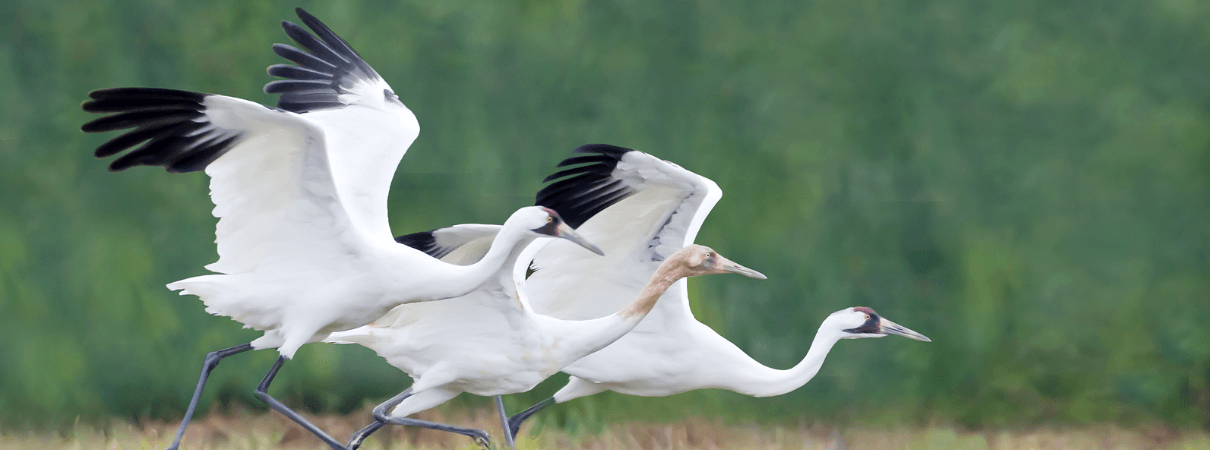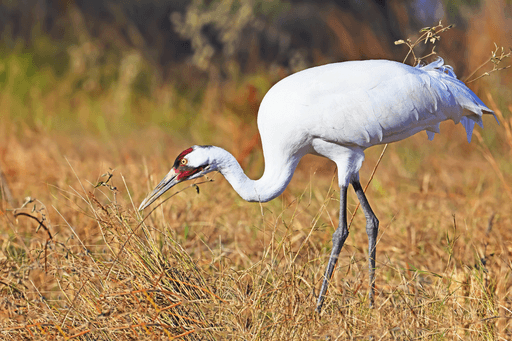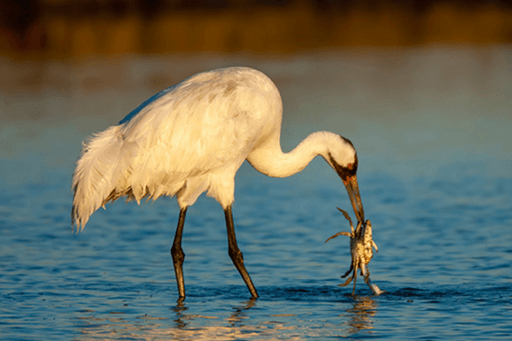Whooping Cranes Face New Threat From Agricultural Fungicide
Whooping Cranes embody the essence of avian charisma. The tallest of North American birds, they are majestic, awe-inspiring, and world famous. But these qualities — powerful as they may be for bird lovers — proved no match for the devastating effects of habitat loss and, in years past, overhunting. Driven by these potent threats, Whooping Crane populations crumbled, falling to 15 birds by 1941. Decades of captive-breeding and conservation work, by a range of cooperating agencies and organizations in the U.S. and Canada, brought the total wild and captive population back to more than 800 birds.

But in 2020, a new threat to these Endangered birds emerged. That's when the Environmental Protection Agency (EPA) hastily approved use of a dangerous fungicide called inpyrfluxam. Conservationists at ABC and other groups are now rushing to protect Whooping Cranes and other Endangered birds, including the Mississippi Sandhill Crane (an Endangered subspecies), from this new threat by asking the EPA to institute commonsense restrictions on the use of inpyrfluxam.
Impact on Cranes

Inpyrfluxam was developed to keep sugar beets, corn, apples, and many other crops free of root rot and other fungus-borne diseases. The fungicide, however, poses significant environmental problems. Testing has shown it to be highly toxic to birds and other wildlife. Short-term exposure led to death in small birds; in larger birds such as quail, chronic exposure led to smaller brood sizes and fewer eggs laid.
Although they are much larger species, cranes are also affected by inpyrfluxam. It affects them in two ways: While foraging in fields, the birds are directly exposed when they eat seeds coated with inpyrfluxam, and they are indirectly impacted when inpyrfluxam leaches into waterways, killing aquatic invertebrates, an important food source. Fewer invertebrates can translate into fewer crane eggs and fewer chicks. In addition, invertebrates, among other protein sources, help fuel Whooping Cranes on their annual migrations; their scarcity can make surviving these dangerous journeys even more difficult for the birds.
Approval Process

Despite the dangers posed to the Endangered Whooping Crane and Mississippi Sandhill Crane, two of North America's rarest birds, the EPA approved inpyrfluxam for sale two years ago. How could the agency responsible for protecting the environment make such a dangerous decision?
To answer this question, a quick review of the EPA's pesticide approval process will be helpful.
All pesticide approvals in the United States are regulated by the Federal Insecticide, Fungicide, and Rodenticide Act (FIFRA). Thanks to FIFRA, EPA must weigh the economic and pest-killing benefits of these chemicals against potential harms that pesticides pose to people or the environment.
A company wishing to register a new pesticide discloses the toxic active ingredients and additives, and states how the chemical will be used. The company also provides testing data to show whether a pesticide is safe for people, the environment, or wildlife.
EPA reviews this information before making a final decision. When risks are identified, the agency proposes “mitigations” — rules and strategies to counteract said dangers, including the cancellation of potential pesticides.
If a pesticide is to be used in an area or manner that could harm a federally listed species, an Endangered Species Act (ESA) consultation begins. This requires a close review of potential dangers to listed wildlife and may result in more mitigations being imposed.
Inpyrfluxam skipped this process and hit the market without the safeguards necessary to protect cranes and other wildlife. Unfortunately, this is the case with the vast majority of new chemicals: Less than 5 percent of all registered pesticides have undergone the ESA consultation process since it was added in 1978.
In recent months, however, the EPA has stepped up its commitment to ESA consultations and has published a new workplan designed to address these concerns. But it still has a long way to go before the approval process adequately protects Threatened and Endangered species.
Inpyrfluxam in Court

Because inpyrfluxam was registered for sale without an ESA consultation, the Center for Biological Diversity successfully sued in 2020 to reverse EPA's initial registration decision and to ensure that a full ESA consultation would occur. As a result, the EPA was ordered to evaluate inpyrfluxam's impact on the Whooping Crane and the Mississippi Sandhill Crane, specifically looking at these birds' range and diet.
Regrettably, the review did not alter EPA's original decision. According to the agency, inpyrfluxam did not jeopardize the birds due to their varied diet and overall range. EPA also ruled that inpyrfluxam posed no concern relating to aquatic invertebrates because the label recommends it for use at least 50 feet from water.
These decisions might seem sound based on available models, but in the real world they are unrealistic. The varied diet of a crane was the reason given for why inpyrfluxam-coated seeds are not a threat, the justification being that these birds eat more than just seeds, so the impact of the toxin is diluted. However, cranes are opportunistic; if a hungry Whooping Crane comes across a freshly seeded field, it will eat those seeds in large volume — even if those seeds are treated with a toxic fungicide. This is the key difference: Just because cranes may eat more than just seeds does not mean they will. Additionally, the formulae used to assess risks from treated seeds are antiquated. The equations are based on observations and assumptions predating the introduction of modern, increasingly potent seed coatings.
Finally, because EPA lacks the capacity to enforce label requirements, it's more than likely that consumers will use inpyrfluxam as they see fit and without accountability, even if that means endangering wildlife by spraying within 50 feet of water — a distance that, even if adhered to, is insufficient to prevent contaminants from reaching waterways.
Conservationists Respond

In conjunction with the International Crane Foundation, ABC has submitted formal comments to the EPA asking that the agency adopt commonsense regulations that will protect Whooping Cranes and other wildlife by restricting the use of inpyrfluxam in the following ways: eliminating inpyrfluxam as a seed coating or banning its use in crane habitat; banning aerial sprays of inpyrfluxam; and increasing the buffer distance around bodies of water to 100 feet. In addition, we will continue building grassroots support to compel the EPA to bolster its pesticide approval process, keeping risky products off shelves, out of the environment, and away from birds.
Changing the way pesticides are registered and reviewed is no small feat — it requires patience and collaboration. ABC remains the only bird conservation group with staff dedicated to pesticide policy, and the support of our community and partners is crucial to our success. We strive to help build a system where protecting the health of birds, habitat, and people is valued over a perceived need to fast-track dangerous pesticides.
Get Involved
There are several ways you can learn more and help protect Whooping Cranes from inpyrfluxam and other dangerous pesticides:
- Tell the EPA to prioritize the health and safety of cranes and other at-risk birds by banning the use of inpyrfluxam as a seed coating and by better regulating its use as a spray.
- Visit ABC's Pesticides page to learn more about the dangers that pesticides pose to birds and humans.
- Sign up for ABC email to keep up with our work and learn more about birds throughout the Americas.



















































